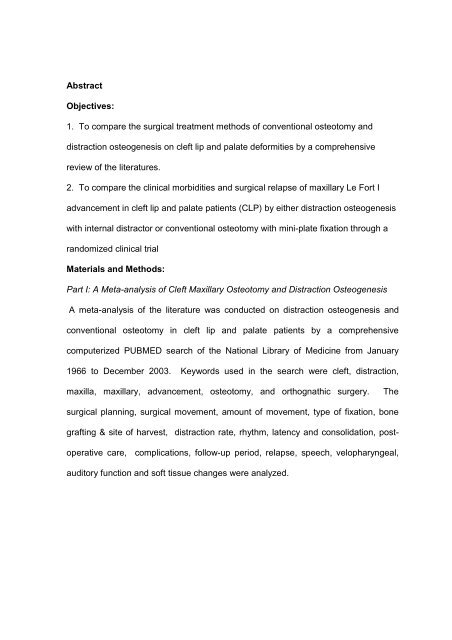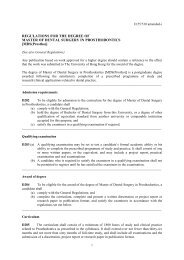Abstract Objectives: 1. To compare the surgical treatment methods of ...
Abstract Objectives: 1. To compare the surgical treatment methods of ...
Abstract Objectives: 1. To compare the surgical treatment methods of ...
Create successful ePaper yourself
Turn your PDF publications into a flip-book with our unique Google optimized e-Paper software.
<strong>Abstract</strong><br />
<strong>Objectives</strong>:<br />
<strong>1.</strong> <strong>To</strong> <strong>compare</strong> <strong>the</strong> <strong>surgical</strong> <strong>treatment</strong> <strong>methods</strong> <strong>of</strong> conventional osteotomy and<br />
distraction osteogenesis on cleft lip and palate deformities by a comprehensive<br />
review <strong>of</strong> <strong>the</strong> literatures.<br />
2. <strong>To</strong> <strong>compare</strong> <strong>the</strong> clinical morbidities and <strong>surgical</strong> relapse <strong>of</strong> maxillary Le Fort I<br />
advancement in cleft lip and palate patients (CLP) by ei<strong>the</strong>r distraction osteogenesis<br />
with internal distractor or conventional osteotomy with mini-plate fixation through a<br />
randomized clinical trial<br />
Materials and Methods:<br />
Part I: A Meta-analysis <strong>of</strong> Cleft Maxillary Osteotomy and Distraction Osteogenesis<br />
A meta-analysis <strong>of</strong> <strong>the</strong> literature was conducted on distraction osteogenesis and<br />
conventional osteotomy in cleft lip and palate patients by a comprehensive<br />
computerized PUBMED search <strong>of</strong> <strong>the</strong> National Library <strong>of</strong> Medicine from January<br />
1966 to December 2003. Keywords used in <strong>the</strong> search were cleft, distraction,<br />
maxilla, maxillary, advancement, osteotomy, and orthognathic surgery.<br />
The<br />
<strong>surgical</strong> planning, <strong>surgical</strong> movement, amount <strong>of</strong> movement, type <strong>of</strong> fixation, bone<br />
grafting & site <strong>of</strong> harvest, distraction rate, rhythm, latency and consolidation, postoperative<br />
care, complications, follow-up period, relapse, speech, velopharyngeal,<br />
auditory function and s<strong>of</strong>t tissue changes were analyzed.
Part II: Cleft Maxillary Distraction versus Orthognathic Surgery: Clinical Morbidities<br />
and Surgical Relapse<br />
29 CLP patients with diagnosis <strong>of</strong> moderate maxillary hypoplasia underwent Le Fort<br />
I osteotomy requiring an advancement <strong>of</strong> 4-10 mm were randomized to ei<strong>the</strong>r for<br />
distraction or immediate maxillary transposition.<br />
In <strong>the</strong> distraction group, active<br />
distraction was commenced at day - 3 after distractor insertion at a rate <strong>of</strong> 1mm per<br />
day until achieving a class I incisor relationship. The distractors were removed<br />
around <strong>the</strong> third post-operative month. In <strong>the</strong> osteotomy group, <strong>the</strong> cleft maxilla was<br />
mobilized to <strong>the</strong> pre-planned class I occlusion during <strong>the</strong> operation and <strong>the</strong>n fixed by<br />
4 titanium mini-plates and screws.<br />
The clinical morbidities were recorded by standardized questionnaires during<br />
operation and post-operatively at 2 and 8 weeks, 3, 6 and 12 months. Skeletal and<br />
dental relapse were assessed by using lateral cephalographs taken pre-operatively<br />
and post-operatively at <strong>the</strong> same interval. Serial comparisons <strong>of</strong> dental and skeletal<br />
cephalometric landmarks were used for <strong>the</strong> determination <strong>of</strong> <strong>surgical</strong> relapse.<br />
Result:<br />
Part I: This search revealed 98 articles. 72 articles were related to cleft maxillary<br />
osteotomy and 26 were related to cleft maxillary distraction. This review revealed<br />
that 1418 cleft patients underwent maxillary osteotomy and 276 patients underwent<br />
distraction osteogenesis. The <strong>surgical</strong> planning <strong>of</strong> <strong>the</strong> two groups studied was<br />
similar. The reported <strong>surgical</strong> movement in <strong>the</strong> distraction group was mainly in <strong>the</strong><br />
anterior-posterior as well as some also in <strong>the</strong> transverse plane. In <strong>the</strong> osteotomy<br />
group, it was only in antero-posterior and vertical planes. The amount <strong>of</strong>
advancement achieved in both groups was quite similar. However, <strong>the</strong> maximum<br />
amount <strong>of</strong> movement reported for distraction was larger.<br />
Part II:<br />
In <strong>the</strong> distraction group, two patients developed mucosal infection around <strong>the</strong><br />
distractors and one has occlusal relapse, whereas in <strong>the</strong> osteotomy group, one<br />
patient encountered haemorrhage from transection <strong>of</strong> <strong>the</strong> descending palatine<br />
vessels during maxillary mobilization, one patient had exposure <strong>of</strong> plate leading to<br />
sinusitis and one patient developed occlusal relapse. For <strong>the</strong> skeletal relapse <strong>of</strong> <strong>the</strong><br />
osteotomy group, a vertical relapse <strong>of</strong> A-point in upward direction was noted<br />
between <strong>the</strong> 2 nd - 8 th week and 8 th -12 th week post-operatively <strong>of</strong> 6% and 33%,<br />
respectively. In contrast, <strong>the</strong> A-point moved fur<strong>the</strong>r downward by 15% and 10% at<br />
<strong>the</strong> same interval in <strong>the</strong> distraction group. In <strong>the</strong> horizontal relapse <strong>of</strong> A and P-points,<br />
a backward <strong>surgical</strong> relapse <strong>of</strong> 21% and 13% was found, whereas in <strong>the</strong> distraction<br />
group, both points moved fur<strong>the</strong>r forward for 25% and 15% during <strong>the</strong> 8 th – 12 th<br />
weeks post-operatively. The results were statistically significant between <strong>the</strong> two<br />
groups.<br />
Conclusion:<br />
Part I:<br />
The literature review revealed that patients who had distraction osteogenesis were<br />
younger than those who had orthognathic surgery. The amount <strong>of</strong> advancement<br />
was significantly greater in distraction as <strong>compare</strong>d to that <strong>of</strong> <strong>the</strong> conventional<br />
osteotomy. There is however lack <strong>of</strong> good data on long term results and relapse on<br />
distraction osteogenesis when <strong>compare</strong>d with conventional osteotomy in CLP
deformities.<br />
The effect <strong>of</strong> Le Fort I maxillary osteotomy and distraction<br />
osteogenesis on velopharyngeal function remains a controversial issue. Both<br />
distraction osteogenesis and conventional osteotomy can induce significant s<strong>of</strong>t<br />
tissue changes affecting <strong>the</strong> facial aes<strong>the</strong>tics.<br />
Part II:<br />
This study highlights that intra-operative and post-operative complications may<br />
develop in ei<strong>the</strong>r distraction by internal maxillary distractor or <strong>the</strong> conventional<br />
osteotomy in CLP patients. Clinical occlusal relapse may develop during <strong>the</strong> early<br />
post-operative period in <strong>the</strong> transposed maxilla with ei<strong>the</strong>r distraction or conventional<br />
osteotomy. Conventional osteotomy by immediate maxillary transposition produces<br />
more skeletal relapse in both vertical and horizontal plane than <strong>the</strong> cleft distraction,<br />
particularly in <strong>the</strong> early post-operative 3 months.





